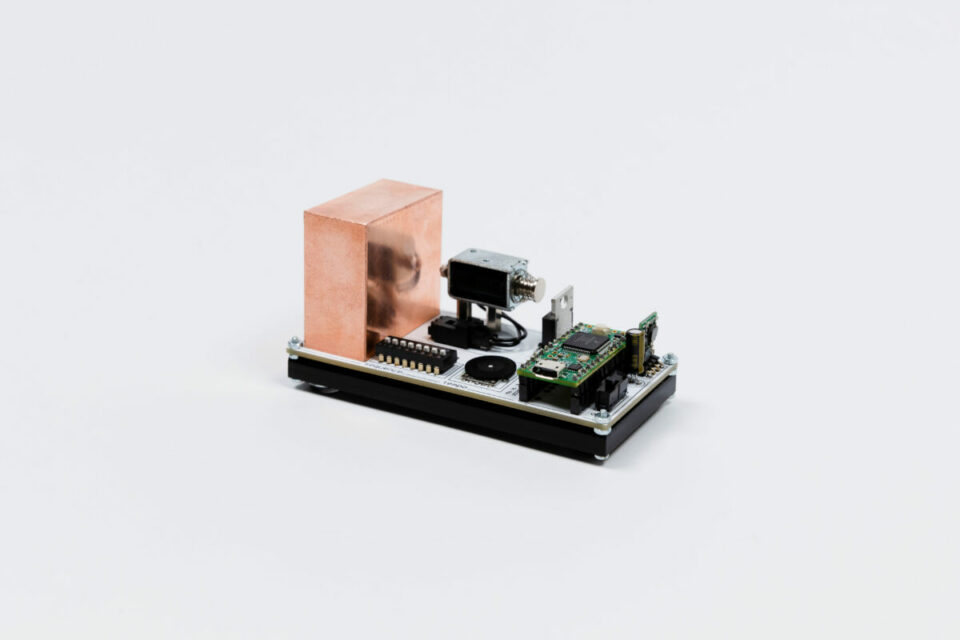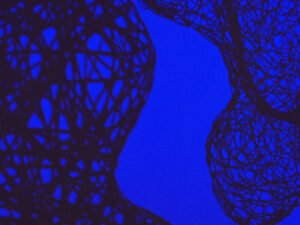Mo H. Zareei is an electronic musician, sound artist, and researcher. His practice builds on an ongoing exploration of brutalism through audiovisual media. Material Sequencer is an electromechanical sound-sculpture, designed to emphasise the physical materiality of sound and sound production. The project celebrates audio as something tactile which can be seen, felt and heard from all angles. Aesthetica asks the shortlisted artist about the idea behind the project, and what can audiences take away from it.

A: What inspired Material Sequencer? How is it personal to you?
MHZ: This project builds on a body of work focused on the sonic interpretation of brutalism. My interest in brutalism – an architectural movement that originates from a drive for material honesty – is rooted in my upbringing in Ekbatan, a planned town in western Tehran, Iran. I grew up in a beautiful concrete megastructure residential complex. In my PhD research, I employed brutalism as a frame of reference for sound-based art practices that embrace the materiality of their raw components through an organised mode of expression. Material Sequencer‘s main premise is a celebration of its austere sonic and physical material. The project is a response to the over-philosophised discourse on sonic materialism which almost ironically overleaps the very essence of what it is concerned with, i.e. matter. To counter this with my work, I’m trying to underscore the physicality and tactility of sound production and the medium that enables it.
A: Could you please us talk through the process of making the piece?
MHZ: My goal was to emphasise the physical materiality of sound and sound production. Being a practitioner of electronic music, I decided to focus on one of the most elemental tools within electronic music production: a simple 8-step sequencer. I custom-designed a circuit board to generate simple 8-step rhythmic structures through the acoustic excitation of blocks of solid matter by a small electromechanical motor. I am interested in revealing the materials and processes that bring an artwork to life, and highlighting the medium as part of the artistic output as well. The medium being electronics here, the functional and aesthetic qualities of the raw material became interchangeable and equally important.
A: What would you like audiences to take away from it?
MHZ: With this work, I’m taking the simple process of electronic rhythm generation outside the black box and highlighting its physical, material and almost sculptural qualities. Presenting the sound-generating process in an entirely visible and tactile form, I’m hoping to highlight the visceral quality of what is at the core of a wide range of styles within electronic and club music: a sequence of repeating pulses. By stripping back the sonic output to these simple and restrictive structures and stretching them temporally, my goal is to bring to attention the intricacy and materiality of the technological process involved in generating a simple beat. Simultaneously, I’d like to emphasise that without physical material sound would not exist.

A: Which artists inspire your work?
MHZ: I‘ve got plenty, but I’d say: Estonian composer Arvo Pärt, German musicians Carsten Nicolai and Christina Kubisch, minimalist sculptor Dan Flavin, Italian-American sound artist and designer Harry Bertoia, Finnish musician Mika Vainio, American composer Steve Reich and Swiss musical artist Zimoun.
A: What does being shortlisted for the Aesthetica Art Prize mean to you?
MHZ: It is a real honour to be shortlisted for this prize and being able to display my work at the exhibition. I received the news when I was visiting my hometown of Tehran, surrounded by the very brutalist architecture that inspired this project and my broader practice as well. That made it extra special.
Zareei features in the Aesthetica Art Prize 2024 Exhibition at York Art Gallery from 16 February – 21 April. Plus, meet over 250 longlisted international artists in our new online gallery.
Want to get involved? The next edition of the Prize is open for entries. Submit your work by 31 August. Win £10,000, exhibition and publication. Find out more here.
All images: Mo H. Zareei, Material Sequencer (2021). Aluminium, brass, copper, concrete, steel. wood, soleniods, electronics.





